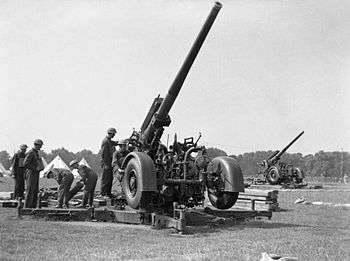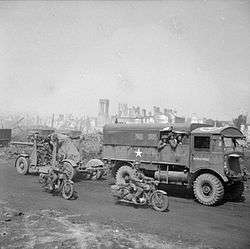106th Heavy Anti-Aircraft Regiment, Royal Artillery
The 106th Heavy Anti-Aircraft Regiment, Royal Artillery (106 HAA Rgt) was an air defence regiment of Britain's Royal Artillery which served during World War II. The regiment was first deployed on home defence duties in Liverpool before deploying to North Africa and Italy before finally returning to the UK to serve in France in 1944.
| 106th Heavy Anti-Aircraft Regiment, Royal Artillery | |
|---|---|
 Royal Artillery cap badge | |
| Active | 1 August 1940–18 December 1944 |
| Country | |
| Branch | |
| Role | Air defence |
| Size | Regiment (3–4 batteries) |
| Part of | Anti-Aircraft Command |
| Garrison/HQ | Liverpool |
| Engagements | Liverpool Blitz Tunisian Campaign Italian Campaign Invasion of Normandy |
Organisation

.svg.png)
Following the failure of the Norwegian Campaign in 1940, the Commander-in-Chief of Anti-Aircraft Command, General Sir Frederick Pile confirmed his personal opinion of the paramount importance of the anti-aircraft (AA) defences. Therefore, Pile pressed for and secured a large expansion of the AA defences during 1940. Among these expansions were; 4 new divisions, many new AA brigades, and many new HAA & LAA regiments.[1][2] On 1 August 1940 the 106th Heavy Anti-Aircraft Regiment, Royal Artillery (TA) was formed and batteries joining shortly;[3][4][5][6][7][2]
- Regimental Headquarters (RHQ) formed on 1 August 1940 in Liverpool
- 327 HAA Bty, formed on 27 April 1940 and regimented 1 August 1940 in 106th HAA Rgt
- 331 HAA Bty, formed on 27 April 1940 and regimented 1 August 1940 in 106th HAA Rgt
- 332 HAA Bty, formed on 27 April 1940 and regimented 1 August 1940 in 106th HAA Rgt
Home Defence
During the summer of 1940, while the Battle of Britain raged over the skies of Southern England by day, yet there were also night raids on industrial cities. Liverpool was heavily attacked for four nights in a row from 28 August, and the regiment was in action almost nightly thereafter, firing almost 2000 rounds during a heavy attack on the night of 28/29 November. The night raids continued into the following Spring, during which period the city and its docks along the Mersey became the most heavily bombed area of Britain outside London. The campaign became known as the Liverpool Blitz, with particularly heavy attacks in December 1940 (the Christmas Blitz).[8][9]
When 106 HAA Rgt was formed in the summer of 1940, the area was bombed so heavily that there were two AA brigades to defend Lancashire, Merseyside, and Greater Manchester. One of these brigades was the 33rd (Western) Anti-Aircraft Brigade which was based in Liverpool and tasked with defending that area, this brigade would be the regiment's home for the next three years. The 33rd AA Brigade was under command of the 4th AA Division which was tasked with the AA defence of Manchester and Liverpool.[2][5][7][10][11][12]
On 16 January 1941, 408 HAA Bty was formed in Arborfield as part of the 206th HAA Training Rgt, from a cadre provided by the 106th. On 10 April, the battery was regimented but removed on 12 October to split into 408 and 'D' HAA Bty (latter to W.A.A[13]'s 3rd HAA Regt). On 2 December 270 (Wentworth) HAA Bty joined from the 91st HAA Rgt, and on the 22nd, 408 HAA Bty was disbanded to form 6 HAA Bty, W.A.A. On 3 October 1942 the regiment had another change when 331 HAA Bty left the regiment to join the 174th (M) HAA Rgt which began the process of formation in Burledon (north Southampton, Hampshire).[3][11][14]
Italy
In June 1943 the regiment arrived in Tunisia and served under Allied Forces HQ in the area until September when it was placed under CRA, Eighth Army in Italy. During the Italian Campaign, the regiment was stationed around the town of Vis (today part of Croatia) provided air defence for the Yugoslav Partisans which operated through the tunnel. The town was the exit and came under heavy Luftwaffe attack towards the end of the campaign.[2][5][15][16][17][18]
During the early months of 1944, the regiment was slated to be disbanded, and began the process in Italy by re-deploying its personnel and equipment to the units which were due to replace them in the AA role for the final push north in Austria. In April 1944 the regiment moved back to the United Kingdom under Commander Home Forces, and delayed from disbandment due to the coming Invasion of Normandy of which it would play an active part and late Operation Diver.[2][5][15][16][18]
Normandy

Just as the regiment returned from Italy, the regiment was assigned to the recently formed 101st AA Bde which was under the command of Brigadier J. G. S. Ross. On the 19/20 August (2 months after the initial invasion) the brigade landed at Utah Beach en route to the coastal town of Cherbourg with the 105th HAA, 106th HAA and later joined by the 99th and 109th LAA regiments. After arriving, five AA brigades were assigned to their respective positions including RAF bases and supporting the Second British and First Canadian Armies. The three other AA brigades were the 76th, 80th, and 101st which were available to back-up the four under command of the two armies in the move forward to the Seine. In September the 5th Royal Marines Anti-Aircraft Brigade arrived and replaced the 101st. Following the brigade's replacement, the regiment started the process of disbandment of 8 September 1944 with RHQ, 327, and 332 Btys disbanded, followed by 270 Bty on 18 December.[2][3][5][19][20][21]
During the Normandy Campaign, the regiment had the following organisation;[3][22][23]
- Regimental Headquarters (RHQ controlling 1 twin LMG and 1 projector, both for RHQ defence)
- 270 (Wentworth) HAA Bty
- Battery HQ
- A Troop (four 3.7 inch-guns, divided into 2 sections in each troop, 2 LMGs (of which 1 is 'twin' and 2 Projectors)
- B Troop (see above)
- 327 HAA Bty (BHQ, C, & D Trps)
- 332 HAA Bty (BHQ, E, & F Trps)
Footnotes
- General Sir Frederick Pile's despatch
- 4th Anti-Aircraft Division (1940) at British Military History. Retrieved 13 February 2020.
- Frederick 1984, p. 780
- Frederick, p. 757.
- 106 Heavy AA Regiment RA (TA) Archived 2011-02-18 at the Wayback Machine at Royal Artillery 1939-45, Archived on 19 March 2005 at the Wayback Machine. Retrieved 10 February 2020.
- Routledge, Table LXV, p. 396.
- 4 AA Division Archived 2015-09-24 at the Wayback Machine at Royal Artillery 1939-45, Archived on 15 December 2014 at the Wayback Machine. Retrieved 11 February 2020.
- Routledge, pp. 394–5
- Routledge, Table LXII, p. 379–80.
- Air Defence Great Britain, Archived on 9 January 2008 at the Wayback Machine. Retrieved 13 February 2020.
- Routledge, Tables LVIII & Table LXV, pp. 376, 396.
- Pettibone, p. 298.
- West African Artillery
- Frederick, p. 758.
- Robert Palmer, Italy 1943-1945:Overview and Higher Formations at British Military History. Retrieved 13 February 2020.
- Routledge, pp. 290-1.
- Routledge, Table XLIV, p. 293.
- Joslen, pp. 465, 467.
- Routledge, p. 315.
- Brayley, North-West Europe, pp. 11-2, 21.
- Ellis, Location 10198.
- Ellis, Location 10555.
- Garry Kennedy and Mike Taylor, Heavy Antiaircraft Battery (3.7-inch)(Mobile), RA at World War II Armed Forces - Orders of Battle and Organizations. Retrieved 13 February 2020.
References
- Frederick, J. B. M. (1984). Lineage Book of British Land Forces 1660-1978, Volume II. Wakefield, United Kingdom: Microform Academic Publishers. ISBN 1-85117-008-1.CS1 maint: ref=harv (link)
- Gen Sir Frederick Pile's despatch: 'The Anti-Aircraft Defence of the United Kingdom from 28th July, 1939, to 15th April, 1945' London Gazette 18 December 1947.
- Charles D. Pettibone, The Organization and Order of Battle of Militaries in World War II, Volume II - The British Commonwealth, Trafford Publishing, Victoria, Canada/Rochester, United States. 2006. ISBN 1-4120-8567-5.
- Martin Brayley, Men-at-Arms, The British Army 1939-45 (1); North-West Europe, Osprey Publishing, Botley, Oxford, United Kingdom, 2001. ISBN 978-1-84176-052-0.
- H. F. Joslen, Orders of Battle; Second World War 1939-1945, Reprinted in Middletown, Delaware by Permission of Her Majesty's Stationery Office, London, United Kingdom, (1960 edition), 2009, (re-printed, 2019). ISBN 978-1843424741.
- Brig N.W. Routledge, History of the Royal Regiment of Artillery: Anti-Aircraft Artillery 1914–55, London: Royal Artillery Institution/Brassey's, 1994, ISBN 1-85753-099-3.
- Col J.D. Sainsbury, The Hertfordshire Yeomanry Regiments, Royal Artillery, Part 2: The Heavy Anti-Aircraft Regiment 1938–1945 and the Searchlight Battery 1937–1945; Part 3: The Post-war Units 1947–2002, Welwyn: Hertfordshire Yeomanry and Artillery Trust/Hart Books, 2003, ISBN 0-948527-06-4.